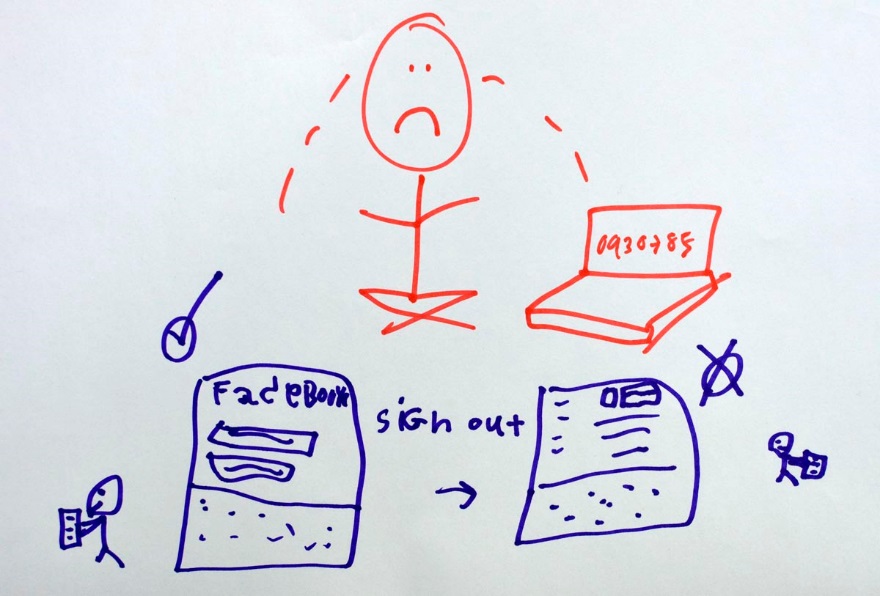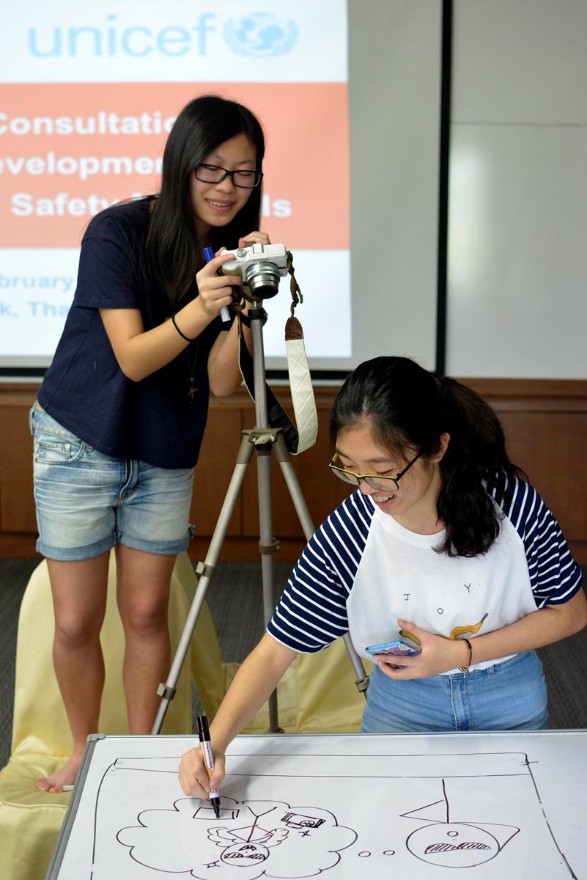Face to face: teenagers help their peers stay safe online
2016-06-07
Nicole, 14, from Malaysia with her creation ‘Billy the Hero’ © UNICEF EAPRO/2016/Andy Brown
From social media to online chatting, the Internet has countless avenues for sharing and connecting with friends and communities. But this open network also carries many risks, especially for children. After falling victim to cyberbullying, Nicole is on a mission to make sure the same doesn’t happen to her peers.
Fourteen-year-old Nicole is a confident and outgoing girl from Kuala Lumpur, or ‘KL’ as locals call it. Famous for its iconic Petronas Twin Towers, her city is the high-rise metropolitan capital of Malaysia. Her parents run a small business selling pens, t-shirts and merchandise. Nicole’s dream is to become an architect and help design the next generation of KL’s buildings.
Nicole is a ‘digital native’ (someone who grew up with the Internet) who spends three to four hours online each day. “My school uses iPads as learning tools and our teachers give us tests online,” she says. “We don’t have any textbooks. It’s easier because we don’t just have one source of information. We can get material from different countries. I like reading the BBC, chatting online with friends, and sharing photos on Instagram.”
But the Internet has not always been a safe space for Nicole – just a few years ago she was a victim of cyberbullying.
“When I was 10 to 12, other children at school picked on me because I was a loner and didn’t have a mobile phone,” Nicole recalls. “Everyone else was on Facebook. We had a laptop at home, so I set up a Facebook profile, but they still bullied me. They posted comments saying I was stupid and didn’t belong. I was in a very emotional state. I cried a lot and wondered why the other kids hated me.”
Nicole’s mum suggested that she read up on cyberbullying, and advised her to stay strong. “I confronted some of the other children at school and asked them ‘Why are you doing this?’” Nicole says. “Afterwards they stopped. I learned to talk more to my parents and not keep everything inside. Since then I’ve been much more open.”
These days, Nicole is a child protection advocate who works hard to help her peers stay safe online. At a recent online safety workshop in Bangkok, she confidently shared her experiences and opinions with other teenagers from across Asia.
Children’s rights online

Detail from a flipchart at the workshop, highlighting online privacy concerns © UNICEF EAPRO/2016/Andy Brown
The United Nations Convention on the Rights of the Child (CRC) is the main international treaty on children’s rights. It was ratified in 1989, before the rise of the Internet. Some of the CRC rights impacted by the Internet include the right to access information and mass media, to be protected from violence and abuse, to get an education, and to take part in cultural activities and play.
“Children’s rights haven’t changed in the Internet age, but the context in which they’re expressed has,” said Afrooz Kaviani Johnson, a UNICEF child protection expert. “For example, digital media gives children greater opportunities to learn, socialize and play. But they also face increased risks, including from cyberbullying and potential abuse.”
To tackle the risks children face on the Internet, UNICEF has partnered with the Child Rights Coalition Asia (CRC Asia) to produce materials by and for children about how to stay safe online. At the Bangkok consultation, Nicole and others helped refine the materials to make them child-friendly and relevant for Asian countries, including Cambodia, China, Hong Kong, Indonesia, Malaysia, the Philippines, Thailand and Vietnam.
The final materials – a print booklet and online videos – aim to give children the skills to use the Internet positively and safely. They will be distributed online, in schools and through children’s networks.
“We are looking to amplify the voices of children in Asia,” CRC Asia Regional Executive Director Amihan Abueva said. “Internet penetration is growing quickly in this region, and children are very exposed to social media. They face dangers including bullying and harmful material, and sometimes do things online that they regret later. But we also need to protect their space for participation and positive Internet use.”
The workshop was an eye-opening experience for the adults involved. It quickly became clear that children in different countries face different issues online. “The Malaysian children were most concerned about bullying, while the Thai kids were more concerned about privacy and security,” Ms Abueva said. “We realized the need to adapt the materials in each country to reflect that.”
It was also evident that today’s teenagers are already highly Internet savvy. “The kids were asking us ‘What’s the [Twitter] hashtag for the consultation?’ We hadn’t thought of having one, so we asked them to come up with one,” she adds, laughing.
Generation Instagram

Angie, 16, and Sarah, 15, from Hong Kong work on their video project © UNICEF EAPRO/2016/Andy Brown
Angie Dai, 16, and Sarah Fang, 15, are from Hong Kong, China. At the workshop, they made a video about online safety. Sarah is an accomplished artist and she drew a series of scenes on a white board telling the story of a boy’s adventures on social media. The journey starts well, but takes a turn for the worse when his online fame attracts unwelcome attention. Angie filmed the process on her camera. “I’ll edit and speed it up afterwards,” she explained.
Sarah lives in Tai Po, New Territories – the part of Hong Kong adjacent to mainland China. She is creative and would like to be a video editor. She uses the Internet to chat with friends, share photos and watch online videos.
Although she enjoys using social media to share photos, Sarah has also had an upsetting experience on it. “Someone set up another Instagram account pretending to be me,” she said. “They used my pictures and made rude, inappropriate comments. It was very disturbing. I told my friends and afterwards the account disappeared.”
Cyberbullying is not simply a case of good kids versus bad kids. Because most children lack life experience, they often make mistakes as they learn to negotiate the on- and offline world. Sarah avely admits that she was once a cyberbully herself. “When I was in Primary 6, I teased a classmate online,” she said. “I said mean things about her. When I went to school the next day, my friends asked me ‘Why did you do that?’ I felt really bad and regretted doing it. It was so impolite. I haven’t done it again.”
Sarah’s friend Angie lives in Shau Kei Wan, on Hong Kong Island. She would like to be a journalist and help defend the island’s tradition of free speech. “I want to speak for my generation and tell people what’s happening,” she said.
Angie has experienced another kind of online risk – cyberstalking. “One time I got a message from a stranger on Facebook,” she said. “We had no mutual friends. He said ‘Hey, you look good, can we be friends?’ I said ‘No, I don’t know you,’ but he kept on bothering me. In the end I blocked him.”
Sarah and Angie agree that talking to their parents is important, although it has its limitations as children are often more tech-savvy than the adults in their lives. “My parents are not familiar with the Internet,” Sarah said. “I set up a Facebook account for my mum, because she wanted to play Candy Crush.”
Ultimately, children like Nicole, Sarah, Angie and others at the workshop from across Asia are best placed to help their peers stay safe online. Together with child protection specialists from UNICEF and CRC Asia, they are now helping their fellow teenagers get the most from the Internet and enjoy its many benefits, while avoiding some of the pitfalls.









